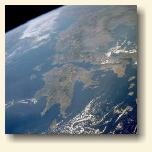
GEOGRAPHICAL DATA SUBSYSTEM

 The geographical
data subsystem consists of two parts:
The geographical
data subsystem consists of two parts:
- a maps base which contains maps with two possible structures
:
- a Raster structure represented
by an array of pixels and
- a Vector structure represented
by a collection of vectors,
- a maps module to manage maps:
- vector-to-raster and raster-to-vector transformations,
- files transfer,
- maps display images processing...
 Maps
can represent two kinds of data:
Maps
can represent two kinds of data:
- qualitative data where each spatial unit is characterized by
a nominal or an ordinal characteristic. For example, a soil occupation
map can be classed in four classes such as
- 1: forest,
- 2: culture,
- 3: wetland,
- 4: urban area;
- quantitative data where each spatial unit is characterized by
a cardinal characteristics. For example, a rainfall map contains data from
0 to 1000mm.






IRIT-UPS


![]()
![]()
![]() The geographical
data subsystem consists of two parts:
The geographical
data subsystem consists of two parts: ![]() Maps
can represent two kinds of data:
Maps
can represent two kinds of data: